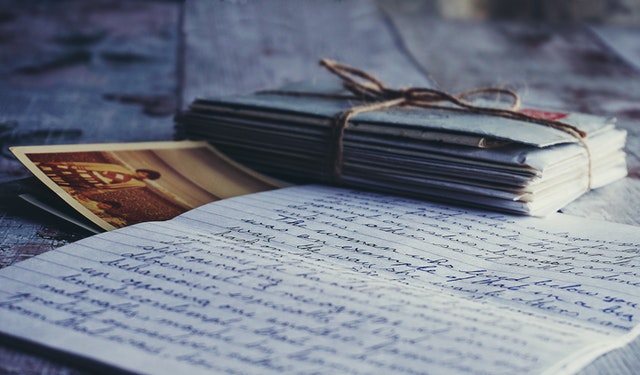
“Dear Bern,
It’s Friday night and I’ve started my second glass of wine. Tom is watching some no-brainer tv so I thought I’d settle in and write to you.”
Thus, began an especially long letter received from a close friend in 1988. The letter flowed like our conversations, covering everything going on in our lives. At that time, when we lived far apart, receiving a letter was the next best thing to having a visit. In this letter, she shared news of the kids, workplace struggles, my sister’s upcoming wedding, her softball team’s calamitous night out and so much more. There was even a little sketch of a hooked rug she was working on. It was a lot of fun to read it so many years later.
I tucked this letter and several others she’d written, into my friend’s Christmas package, returning them to her.
The old cards and letters show up every decade or so during my efforts to minimize clutter. I can never resist re-reading them, indulging the sentimentality.
Most letters tell stories. The ones I received from teenage friends shared gossip and their dreams for the future. Family members’ letters dished out advice, family history and were often full of joy, grief and love. Lots of weather reports were included as well. Loved ones captured and then shared what was important in the moment. Did anyone else save the annual Christmas letters that were so popular for a while?
Not long ago, I read The Guernsey Literary and Potato Peel Pie Society, a novel written as a series of letters and telegrams sent and received by the protagonist. Reading it reminded me how much I like that format. I learned that novel and short story writing using letters, diaries, newspaper articles, emails, etc.; even combining them in the same story, is called epistolary form.
Wikipedia describes the epistolary format as less dialogue driven, with more emphasis on thought, feeling and emotion. Instead of being in the action with the protagonist, most ‘scenes’ are filtered through the character and presented as memories. This format can add greater realism to a story because it mimics the workings of real life.
For these reasons, this format is very interesting to me. Stories can be told by a singular character, through correspondence between two characters or among multiple characters. One just has to keep track of who is writing to whom and why.
I have a project that could provide some practise using the epistolary format. Many years ago, I saved a box of emails between a friend and I with the intent to condense them to a memento of a wonderful time in her life. She was attending art college and her wild enthusiasm was evident every single day. Her creativity had been ignited. It’s an editing job. The words are already written.
In our world of instant communication, it is fun to send and receive letters in the mail. I try to keep a tradition of writing to the young folks in my life. Purging the old letters is harder. I still have a couple of years’ worth of correspondence between seventeen-year-old me and a U.S. sailor I met on a dock in Naples, Italy.
Another story to tell.
Hi Bernice. I have loved chatting with you in every format possible over our many many years of friendship, and we have many more stories to come. Lovely writing as always. Chat soon, Joyce